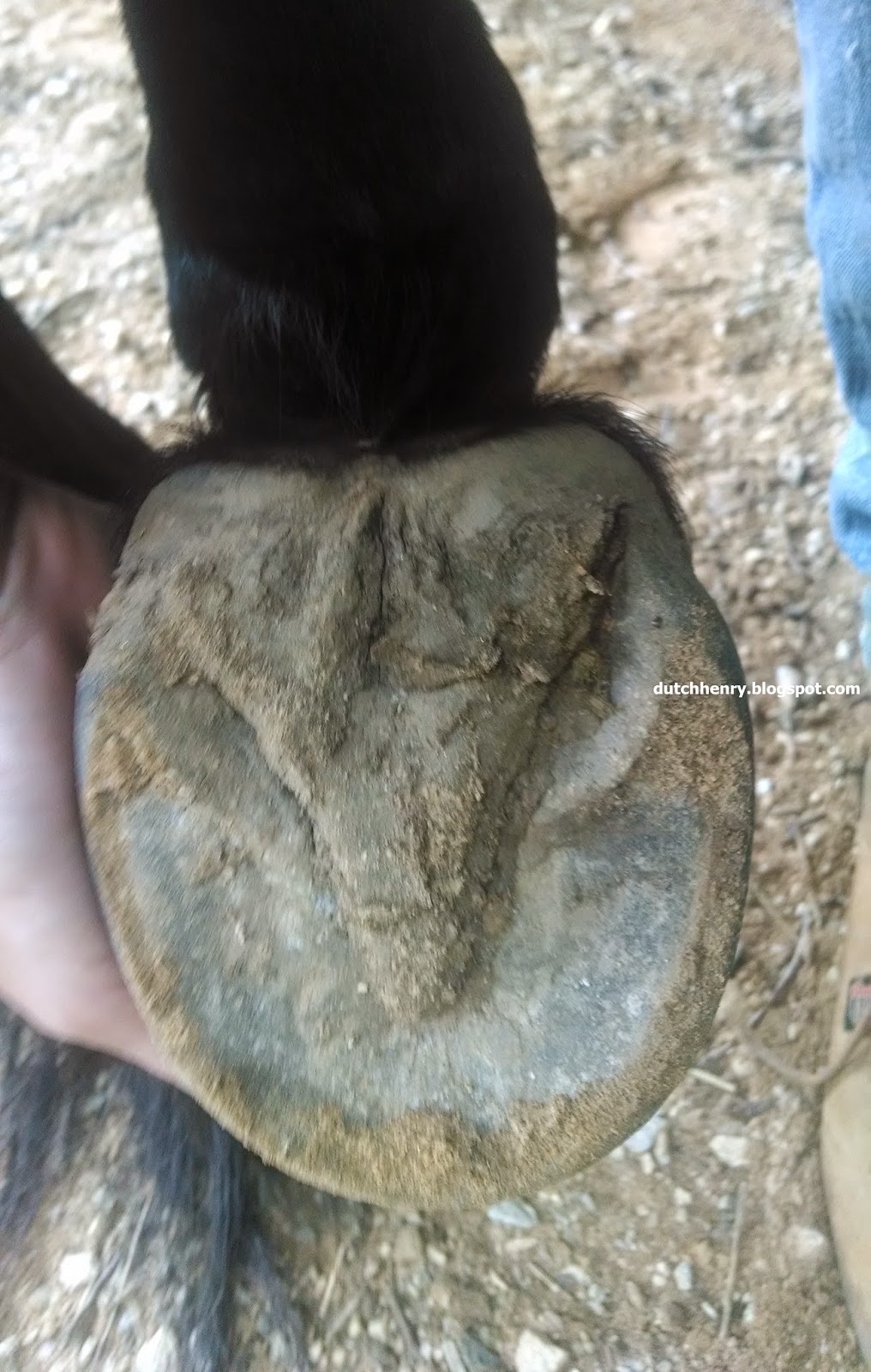Howdy Friends,
Kessy's never had shoes in her twelve years. She came to me
at seven with a few issues. I trim her feet every three weeks, I feel for healthy bare feet most horses
are best served with a three or four week schedule. The eight or ten week
schedule is far too long and can encourage flares and stretching of the lamina
or white line. Yes there are some horses that can go much longer, Pete Ramey
says in his book he has one who needs trimming only twice a year, but for
most horses and situations I feel three weeks is best. I maintain Kessy's feet
with a sharp rasp, do all the shaping from the top down, holding the rasp on a
good angle so we get the good bevel, or mustang roll, as Jamie Jackson calls it.
In full disclosure the photos in this story were taken after Morgan Whitmer
trimmed Kessy, she has been for the past three trimmings while I heal up from
heart surgery. Every thought in this story comes from what I've read, seen and
experienced, and by that formed my own opinion. I share my thoughts with the
hope some folks may benefit, but they are my thoughts so feel free to disregard.
While rasping, from the top down, I only work on the area to
bevel, and angle my rasp to get that nice bevel of about ¾ of an inch. I never
rasp down over the entire hoof to "clean it up," as we see so often,
that removes precious live material important for sealing, growth and hoof
health. I look at the sole before I start, clean it with a brush, not a
hoof knife.
 |
| Kessy's hinds post trim. It took me 6 months to get her hind toes correct. |
Another opinion I have is we clean our hoofs far too often and
thereby strip away important live tissues put there to guard against disease
and infection. If the horse has room to roam with pea gravel or other hard
surface she will keep her feet clean, and healthy. I think I clean Kessy's feet
twice a year with a hoof pick, some years not that often. From the bottom I judge toe length, heel
growth, balance, heel bars etc. I only trim the bars if they are long enough to
fold over, which is rare for me indeed.
 |
| Kessy's RH bottom post trim.Don't you love that sole and frog?! No nippers or hoof knife will touch this sole. |
The view from the bottom tells me most of what I need to do.
Then I set her foot down have a look at balance, position and angle, and start rasping
at the toe. The toe is my guide as, if the horse is well maintained, she will
always tell you where it should be by wear. No more than one third of the hoof
should be in front of the apex of the frog.
 |
| Measuring Kessy's LF we see her hoof is 5 inches - her frog apex is 3 and 5/8 leaving exactly one third of her foot ahead of the frog apex. Perfect. Be sure to check this on your horse. |
If the bottom inspection tells me
the heels are slightly out of balance, or a flare wants to start (which is
never in my case, but wanted to mention because often a flare will tip its hand
on the bottom before even showing an angle change on the hoof wall.) I angle my
rasp even more sharply in those areas to thin the wall more there so she can wear
away the wall that needs to go, and shape her hoof naturally in a way best for
her. Now it goes without saying the horse must have room to roam, not a 20 by
20 paddock or stall, but that's a story for another time.
And that’s about all I do. I do not trim the frog, or pare
or scrape the sole. That again removes precious live, or dead tissue, there for
a reason. It will wear away naturally when she moves about. I rasp the wall
even with the sole so she walks as designed on her sole, not her hoof wall.
That helps prevent that ugly black line around sole and hoof wall which can allow
disease and infection into the lamina, and of course allows the suspensory
tissues within the foot to remain tough, vigorous and strong and not weekend by
excessive stretching ... and builds rock tough soles.
 |
| Here you can see the arch in Kessy's RH hoof wall. |
One last thought about
rasping only from the top down and following the hoof, in that way I can
maintain the natural arch in Kessy foot. Yes the hoof wall does and must have
an arch, something that cannot be maintained by rasping flat across the bottom
of the foot.
Of course trimming is only one part of a healthy barefoot
horse. Housing, exercise, diet and health care all are equally important. I've
thought about writing this little story for a while now because there seems to
be a lot of folks making barefoot trimming too complicated. It's not. Keep it
simple, leave the bottom and soles alone ... And as Pete Ramey says, "Take care
of the toes and the heels will take care of themselves." I recommend both
Pete Ramey and Jamie Jackson's books.
 |
| Kessy says thanks and have a fun day. |
Have a wonderful barefoot time and Gitty Up, Dutch Henry



